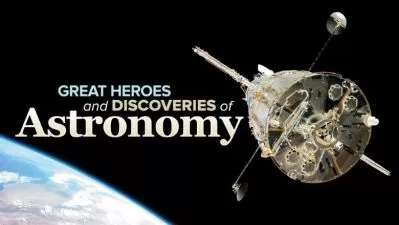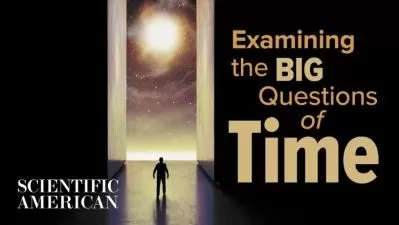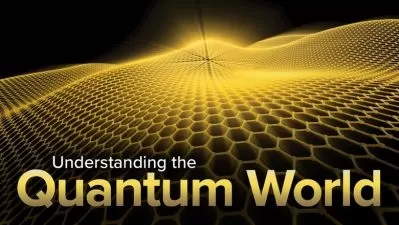Black Holes Explained
Alex Filippenko
6:19:10
Description
Imagine a region in space where the force of gravity is so strong that nothing—not even light—can escape. A region with physical conditions so extreme that they have not yet been reproduced in any terrestrial laboratory. A region so dense that an object as tiny as a walnut would have the same mass as our entire planet.
This phenomenon—first formed in the equations of Einstein and popularized in the stories of science-fiction authors—is a black hole: one of the most exotic, mind-boggling, and profound subjects in astrophysics.
Black holes are at the heart of some of the most intriguing phenomena in the universe. Not only that, they are ideal gateways to fundamental and cutting-edge concepts in astronomy, including the following:
- General relativity: Einstein's general theory of relativity provides the framework for understanding black holes, in which the warping of both space and time is so great that they are effectively cut off from the rest of the universe.
- Monsters at the heart of galaxies: Detailed studies of the centers of galaxies reveal that supermassive black holes are common, with masses of millions to billions of suns. Nearly every large galaxy has one.
- Wormholes: According to general relativity, black holes may be connected to passages through space-time known as wormholes. The jury is still out on whether they exist and whether they would allow time travel and trips to other universes.
- Is the universe like a hologram? Quantum theory suggests that information is not lost inside a black hole but instead is encoded around it like a hologram—a phenomenon that may characterize the universe as a whole!
Indeed, the idea that the universe itself has properties similar to black holes shows that these objects play a pivotal role at all scales: from the truly cosmic to the subatomic realm, where theory suggests the existence of mini-black holes that may have been created in the aftermath of the big bang and that could be produced in the latest generation of particle accelerators.
Nearly everyone has heard of black holes, but few people outside of complex scientific fields understand their true nature and their implications for our universe. Black Holes Explained finally makes this awe-inspiring cosmological subject graspable, with 12 lavishly illustrated lectures by veteran Great Courses Professor Alex Filippenko, a distinguished astronomer and award-winning teacher at the University of California, Berkeley.
Travel into a Black Hole
No movie, novel, or other fictional treatment of black holes matches Professor Filippenko's absorbing presentation of the actual science behind these amazing objects. In Lectures 8 and 9 he uses computer simulations created by fellow astronomers to conduct a virtual tour around and into a supermassive black hole, and then through a wormhole to another universe. Among the features you investigate are these:
- Einstein ring: As you approach a black hole, the starlight behind it spectacularly bends in a kaleidoscopic effect called gravitational lensing. This phenomenon can produce a series of halos known as Einstein rings.
- Photon sphere: Closer to a black hole, you come to a zone where an object must orbit at the speed of light to avoid falling in. Here, light can move in circular orbits and, in principle, you can look forward and see the back of your head.
- Event horizon: Continuing your plunge, you reach a boundary called the event horizon. Once you cross it, you can't return. Anyone watching from outside sees time come to a standstill, as you appear to stop and motionlessly fade from view.
- Singularity: After crossing the event horizon, you are only a minute away from the singularity, the hypothetical point of infinite density. Powerful tidal forces squeeze and stretch your body, until you are ultimately crushed to oblivion.
Mission Invisible
Recently elected to the prestigious National Academy of Sciences, Dr. Filippenko has devoted much of his research career to black holes, discovering some of the best evidence for the existence of stellar-mass black holes in the Milky Way Galaxy, and participating in studies of supermassive black holes using the Hubble Space Telescope.
Drawing on extensive graphics, including hundreds of stunning astronomical images, Dr. Filippenko shows how scientists have been able to read the evidence to surmise a great deal about objects that are inherently invisible. Among the most dramatic clues are high-energy beams of radiation that were first detected by spy satellites in the 1960s. These powerful "gamma-ray bursts" were long a mystery, but they are now thought to be the dying gasps of massive stars in distant galaxies, collapsing to form black holes.
Dr. Filippenko also dispels several myths about black holes, such as that they are "cosmic vacuum cleaners," drawing in matter from afar with irresistible force. In fact, if the sun were compressed to form a black hole, there would be no effect on the orbits of the planets. Similarly, fears that mini-black holes created by particle accelerators will grow and devour the Earth have no basis in physics.
In popular usage, a black hole is a place of utter emptiness. But in this engaging course, you learn about how there is much more to them than that. Astronomers have brought black holes out of the shadows to reveal that they are a widespread and vital phenomenon in the universe with unexpected implications for all scales of reality. Black holes are intriguingly counterintuitive, gratifyingly comprehensible, and surprisingly relevant to our overall understanding of the universe—as you will discover in Black Holes Explained.
More details
User Reviews
Rating
Alex Filippenko
Instructor's CoursesDr. Alex Filippenko is Professor of Astronomy and the Richard and Rhoda Goldman Distinguished Professor in the Physical Sciences at the University of California, Berkeley. He earned his B.A. in Physics from the University of California, Santa Barbara, and his Ph.D. in Astronomy from the California Institute of Technology.
Dr. Filippenko's research accomplishments, documented in more than 500 scientific publications and 600 abstracts and astronomical circulars, are among the most highly cited in the world. Science magazine credited two international teams of astronomers (on which he was the only coauthor contributing to both teams) with the top "Science Breakthrough of 1998" for research on exploding stars (supernovae), which shows that the universe is expanding at an accelerating rate, propelled by mysterious "dark energy." Professor Filippenko received a share of the 2007 Gruber Cosmology Prize for this discovery, work that went on to receive the 2011 Nobel Prize in Physics. Professor Filippenko also leads the world's most successful robotic search for exploding stars.
Dr. Filippenko was elected in 2009 to the National Academy of Sciences, one of the highest honors accorded to a U.S. scientist. He has also been recognized with several major awards, including the 2010 Richard H. Emmons Award for excellence in the teaching of college-level introductory astronomy for non-science majors from the Astronomical Society of the Pacific, the 2007 Richtmyer Memorial Award of the American Association of Physics Teachers, the 1997 Robert M. Petrie Prize of the Canadian Astronomical Society, and the 1992 Newton Lacy Pierce Prize of the American Astronomical Society. He was a Guggenheim Fellow in 2001 and a Phi Beta Kappa Visiting Scholar in 2002.
In 2006, he was honored nationally as the "Outstanding Doctoral and Research Universities Professor of the Year" by the Carnegie Foundation for the Advancement of Teaching and the Council for Advancement and Support of Education.
At UC Berkeley, Dr. Filippenko's teaching awards include the Donald S. Noyce Prize for Excellence in Undergraduate Teaching in the Physical Sciences and the Distinguished Teaching Award. He was also voted the Best Professor on Campus nine times in student polls.
Dr. Filippenko is coauthor of The Cosmos: Astronomy in the New Millennium, now in its 4th edition (2013), and winner of the 2001 Texty Excellence Award for best new textbook in the physical sciences. He has played a prominent role in numerous television documentaries, including about 40 episodes spanning six seasons of The Universe on The History Channel.

The Great Courses
View courses The Great Courses- language english
- Training sessions 12
- duration 6:19:10
- English subtitles has
- Release Date 2023/05/09

















